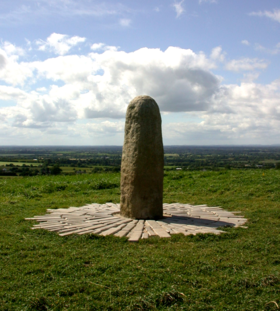Sunday 23rd. February 2014. (Ian Adamson was the historical tour guide all day).
- 09:00am – Bus pick up at Derryhill shops, Rathcoole.
- 09:15am – Bus pick up at Crues. football club, Shore Road.
- 11:00am – Tour of Newgrange & Bru na Boinne (Bend of the Boyne) Centre, telling the ancient history of the area from 11am to 11:45am, then boarded a mini-bus to take us out to Newgrange for 12am, the Newgrange tour lasted one hour then the mini-bus brought us back to the visitors centre for 1:15pm.
Brú na Bóinne Visitor Centre interprets the Neolithic monuments of Newgrange, Knowth and Dowth. The extensive exhibition includes a full scale replica of the chamber at Newgrange as well as a full model of one of the smaller tombs at Knowth.
All admission to Newgrange and Knowth is through the Visitor Centre, there is no direct access to these monuments. We were brought from the Visitor Centre to the monuments by shuttle bus.
| Archaeological Ensemble of the Bend of the Boyne | |
|---|---|
 |
Newgrange was built about 3200 BC, during the Neolithic period, which makes it older than Stonehenge and the Egyptian pyramids. Newgrange is a large circular mound with a stone passageway and chambers inside. The mound has a retaining wall at the front and is ringed by ‘kerbstones’ engraved with artwork. There is no agreement about what the site was used for, but it has been speculated that it had religious significance – it is aligned with the rising sun and its light floods the chamber on the winter solstice. It is the most famous monument within the Neolithic Brú na Bóinne complex, alongside the similar passage tomb mounds of Knowth and Dowth, and as such is a part of the Brú na Bóinne UNESCO World Heritage Site. Newgrange also shares many similarities with other Neolithic constructions in Western Europe, such as Maeshowe in Orkney, and the Bryn Celli Dhu in Wales.
After its initial use, Newgrange was sealed and it remained so for several millennia, later appearing in Irish mythology and folklore. It first began to be studied by antiquarians in the 17th century AD and archaeological excavations took place at the site over the following centuries. In the 1970s, the front of the monument was reconstructed, although some have questioned this move. Today, Newgrange is a popular tourist site and, according to the archaeologist Colin Renfrew, is “unhesitatingly regarded by the prehistorian as the great national monument of Ireland” and as one of the most important megalithic structures in Europe.
- 01:30pm – Three course set lunch with tea/coffee at the Tea Pavillion on site. (Veg soup, Beef & Guinness with baby potatoe, apple pie & custard).
- 02:15pm – Bus pick up for Hill of Tara.
- 02:30pm – Walking tour of the anicent Hill of Tara, Boyne Valley. Co. Meath.
The Hill of Tara (Irish: Cnoc na Teamhrach, Teamhair or Teamhair na Rí), runs between Navan and Dunshaughlin. It contains a number of ancient monuments, and according to tradition, was the seat of the so-called High King of Ireland.
| Hill of Tara Cnoc na Teamhrach |
|
|---|---|
 The Lia Fail The Lia Fail |
- A Royal Place – In prehistory and historic times 142 Kings are said to have reigned in the name of Tara. What is reputed to be the coronation stone, the Lia Fail or Stone of Destiny has rested here down the ages. And it was here that the most powerful of Irish Kings held their great inaugural feasts and were approved by Earth Mother Goddesss Maeve
A Sacred Place – In ancient Irish religion and mythlogy, Tara was revered as a dwelling of the gods and an entrance place to the otherworld of eternal joy and plenty where no mortal ever grew old. In the legends of St Patrick’s mission to Ireland he is said to have first come to Tara to confront the ancient religion in its most powerful sight. - 03:30pm – Bus pick up for Belfast.
Finally we travelled to the Bridal Loanen in Warrenpoint to see the Coronation Stone of the Iveagh Cruthin.The story is that this was the stone on which the head of the MacGuinness clan received his initiation. It was called ‘Cusleac Aonguis’ or the Footstone of Aongus – from Aongus to MacAongus to MacGuinness or Magennis is an easy transition. According to tradition the young potential chieftain dressed in tight-fitting clothes of many colours, and with a jacket of gilded leather and embroidered silk held by a gold brooch, would ‘step on the Stone of Fate’: .. flinging off his right sandal and placing his foot in the indentation on the Stone, he would be given ‘the white Wand of Power’, which he would place in the socket of the Stone. Finally a gold sandal would be put on his foot and he would be proclaimed ‘The MacGuinness’, with a great fanfare of trumpets.

I first saw it as a boy when it was neglected and overgrown as in this old photograph, but is now looked after by Newry and Mourne Council..The Dalaradia organisation will see to it that the Coronation Stone of the Kings of Ulster at Crew Hill will be properly cared for as well.
- 06:45pm – Drop off Crues. football club, Shore Road.
- 07:00pm – Drop off Derryhill shops, Rathcoole.
.